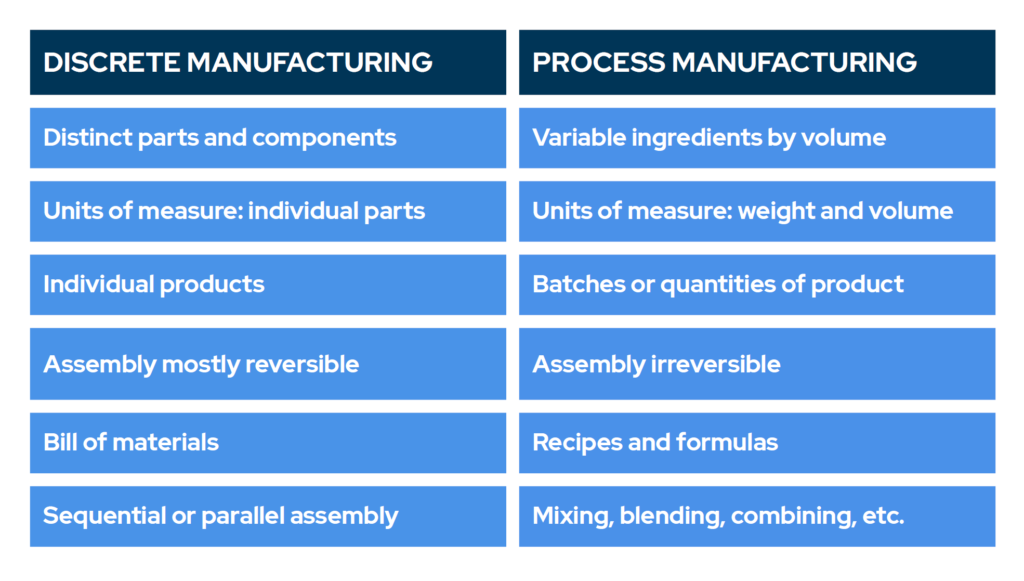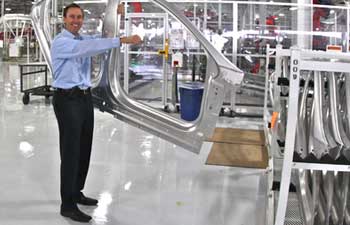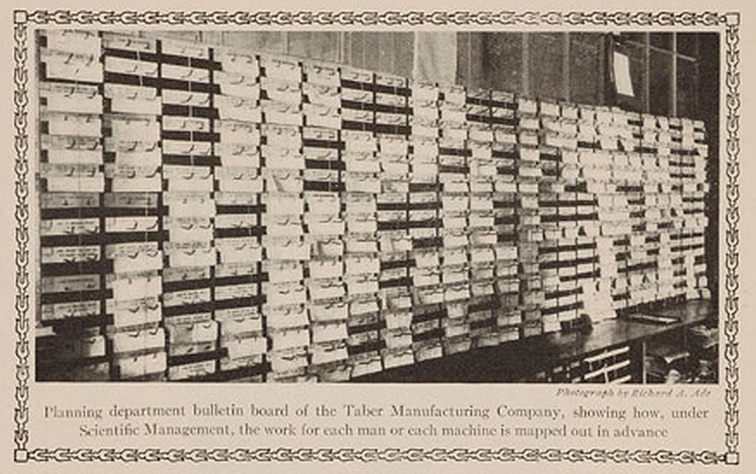Discrete vs. Process Manufacturing – How Do They Differ?
Discrete manufacturing implies producing distinct items that require assembly along a production line. Process manufacturing, on the other hand, produces goods by mixing or combining raw materials in a manufacturing process. In this article, we will explore key differences between the two manufacturing types and look at examples of each.

You can also listen to this article:
What is discrete manufacturing?
Discrete manufacturing is a type of manufacturing process in which components are assembled to create individual finished goods. These types of products are made up of many individual parts, the total number of which may often reach tens of thousands. For example in the case of cars, agricultural or military equipment, computer servers, etc.
To designate all the individual parts that a product consists of and enable the effective management of their inventory, discrete manufacturers rely on using bills of materials (BOMs). If the sub-assemblies that an end-product is made of require prior assembly as well, layered or multi-level BOMs are used to keep track of the complexity.
Another key tenet in discrete manufacturing is the sequence of assembly. Depending on the type of workflow (job shop, batch production, mass production, etc), products are usually assembled in many phases and in different, mostly sequential, workstations. This makes keeping track of the production routings of the product lineup a key requirement for discrete manufacturers. In many discrete manufacturing workflows, products can also be at least partially disassembled or reassembled.
For example, a smartphone is made up of a variety of individual components – the LCD screen, the motherboard, the battery, etc. Each of these needs to be assembled separately before the end product can be compiled in the final assembly phase. While it is possible to assemble the LCD screen and the power supply separately, installing them on the phone’s mainboard requires sequential routing.
What is process manufacturing?
Process manufacturing is a production method in which finished products are created by mixing together raw materials and ingredients. This involves boiling, blending, combining, or otherwise joining the ingredients together in a “process” which outputs a volume of end-product, instead of individual units. For the most part, therefore, process manufacturing occurs in bulk quantities using a batch production workflow.
Instead of BOMs, process manufacturers use recipes and formulas to determine the constituents of their products. It is, therefore, crucial that the production planning system that a company employs has the technical capacity to accommodate recipe control, as well as units of measurement (UOM) conversions and scalability. If the formula or a recipe of a product is scalable, different size batches of a product can be created using the same formula.
For example, if a factory produces cupcakes, it makes sense to produce the frosting for a batch of similarly flavored ones all at once, rather than mix the ingredients together for smaller batches. If the inventory only has enough ingredients for half a batch, however, formulas can be scaled down to produce half the amount of topping, rather than having to create new formulas for it. This is distinct from discrete manufacturing where it is not possible to create half a component like a motherboard, if only half of the required capacitors are in stock.
Unlike in discrete manufacturing, the materials that make up the final product in process manufacturing are not easily identified after they have been processed. Whereas items produced in discrete manufacturing are usually able to be disassembled back to their original components, products made by mixing components together are not. For example, it is impossible to make shale oil back into coal or whipped cream back into milk, whereas an LCD screen can be dismounted from a phone in most cases.
Discrete vs. process manufacturing key distinctions
In a nutshell, the discrete manufacturing process involves creating individual finished goods like automobiles or smartphones. These are made up of parts, assembled using screws and nuts or other fixtures, and can usually be taken apart at least partially later on. Process manufacturing, on the other hand, produces goods that cannot be broken down into individual parts, like paint, composites, plastics, or foodstuffs. These types of goods are usually made in batches and from ingredients that are mixed together in irreversible processes. Discrete manufacturers use bills of materials to designate the contents of the products. Process manufacturers rely on formulas and recipes, instead.

In reality, a combination of both discrete and process manufacturing is used in the manufacture of many end products. For example, a car mainly consists of a multitude of components and fixtures, but also paint, oils, and other fluids applied to many of its parts. Conversely, a finished bottle of smoothie consists of the fruits and juices combined via process manufacturing, but also the bottle, cap, and labels, applied discretely.
Discrete vs. process manufacturing market associations
Discrete manufacturing is mostly associated with vertical markets such as machinery – appliances, machine tools, farm equipment, watches, etc.; electronics – computers, televisions, smartphones, tablets, etc.; defense and aerospace – fighter jets, tanks, submarines, drones, etc.; high-tech – industrial robots, agricultural vehicles, industrial telecommunication arrays, etc.; automotive and transportation – cars, trucks, buses, vessels, etc.
Process manufacturing companies are most common in the following markets: foods and beverages, food processing, paints and coatings, tires, steel, aluminum and other metal fabrication, semiconductor fabrication, cosmetics, pharmaceuticals, textiles, plastics, petrochemicals, etc.
Both discrete and process manufacturing can be set up in either make-to-stock or make-to-order workflows. However, generally speaking, make-to-order is more common among discrete manufacturers, whereas process manufacturers mostly use make-to-stock process flows. This is in part due to the fact that process manufacturers tend to produce goods in high volumes, whereas discrete manufacturers often create bespoke equipment to specific customer requirements.
Managing discrete and process workflows with manufacturing software
In order to effectively manage complex BOM structures, ensure correct routings, plan and schedule workstations, and track the myriad of components moving between the inventory, assembly lines, and the whole supply chain, a powerful MRP system or manufacturing ERP software is an absolute requirement for modern discrete manufacturers. First and foremost, it’s the complex BOM control and the corresponding inventory and supply chain management that lies at the heart of a discrete manufacturing MRP/ERP solution.
Process manufacturing has its own unique requirements. Here, a flexible recipe or formula control is the key functionality without which managing workflows is almost unthinkable in modern process manufacturing facilities. Recipes need to be scalable, units of measurement convertible, and ingredients and their expiration dates tracked precisely to ensure profitability and regulatory compliance. Comprehensive inventory management remains as critical a requirement as for discrete manufacturers, albeit for somewhat different reasons.
For SME manufacturers looking for a comprehensive solution catering to both discrete and process manufacturing needs, MRPeasy stands out as the ideal choice. MRPeasy’s powerful bills of materials functionality enables the efficient management of complex assemblies and components and their inventories. Process manufacturers, on the other hand, benefit from MRPeasy’s intricate recipe control, seamless unit of measurement conversions, and effective routing functionalities, enabling precise formula management for consistent and high-quality production.
MRPeasy’s robust quality control measures ensure compliance with industry standards and customer expectations. Furthermore, the built-in traceability system provides a transparent view of the entire supply chain and production process, simplifying cost accounting and instilling confidence in regulatory bodies.
Whether you are a discrete or process manufacturer, MRPeasy empowers your operations with a versatile and user-friendly system to enhance productivity and accelerate growth.
Key takeaways
- Discrete manufacturing and process manufacturing describe the way in which goods are produced as well as the type of manufacturing process a company has set up.
- Discrete manufacturers create individual products that consist of many different components and require assembly.
- Process manufacturers produce goods in bulk or batches out of ingredients that require mixing, boiling, or otherwise joining them together in a (chemical) process.
- Discretely produced items are mostly able to be disassembled while processed goods are not. Realistically, many products use a combination of both process and discrete manufactured parts.
- Discrete manufacturing uses Bills of Materials and routings to designate the contents and assembly sequence of produced items, while process manufacturing relies on formulas and recipes.
Frequently asked questions
Discrete manufacturing involves assembling distinct components into finished products like smartphones, cars, electronics, furniture, etc. In process manufacturing, however, ingredients are mixed together to create things like beverages and foods, chemicals, plastics, pharmaceuticals, etc.
Discrete manufacturing is characterized by producing distinct, countable units, while batch process involves producing goods in specific quantities or “batches” with a defined production process for each batch. The discrete and batch processes differ by the nature of the product, production volume, and industry requirements.
In manufacturing, discrete refers to a type of manufacturing process in which goods are produced out of individual components and sub-assemblies using fixtures and mechanical assembly. Discrete manufactured goods rely on bills of materials (BOMs) to designate the product’s constituents and routings to designate the order and sequence of assembly within a manufacturing plant.
An example of a discrete manufacturing company is a car manufacturer that produces a line of different cars, each with its own bill of materials, on assembly lines. The cars are assembled by adding parts and sub-assemblies to the car’s mainframe in sequential automated or manual workstations until finally, a final product consisting of thousands of individual parts is assembled.
You may also like: Types of Manufacturing Processes – A Comprehensive Guide




